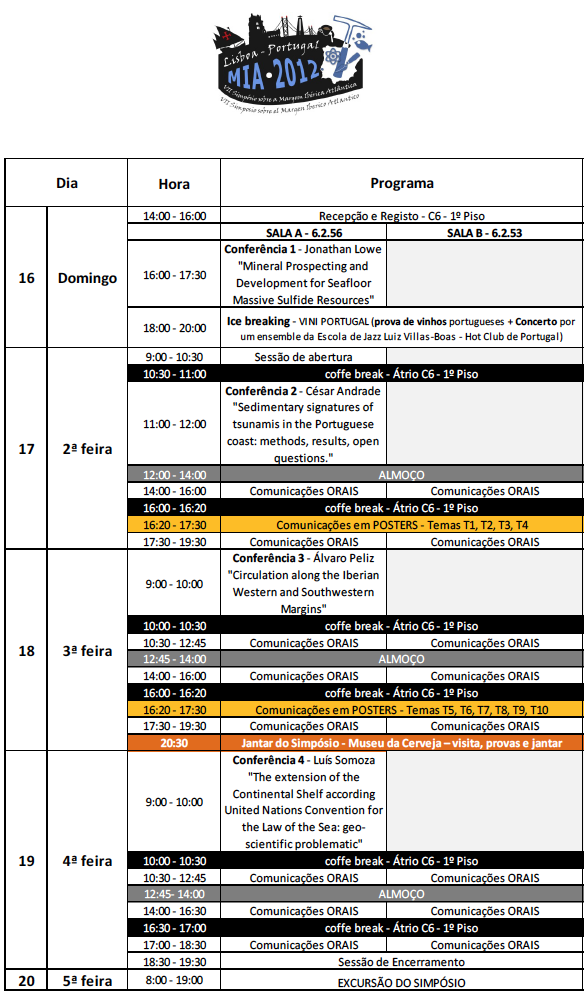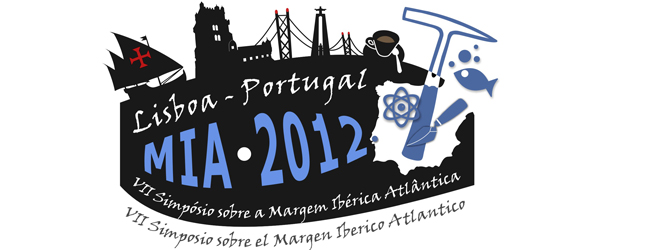Programa Científico
Programa Geral [PDF]
Programa das Comunicações [PDF]
Programa de posters [PDF]

Conferências [PDF]
Conferencistas
Álvaro Peliz – Universidade de Lisboa, Faculdade de Ciências da Universidade de Lisboa, Centro de Oceanografia.
PhD in Physics (Ocean Dynamics) at the University of Aveiro. His research focus on mesoscale dynamics, shelf and slope processes, and the circulation of the Mid-latitude NE Atlantic and Iberian Margins. He is at present a researcher at the IDL, U. Lisbon.
Title
Circulation along the Iberian Western and Southwestern Margins
Abstract
Despite of it status and recurrent classification as an upwelling (wind – driven) eastern margin there are several other equally important processes that together with forcing make the Iberian Margins circulation specially interesting. Recent advances in the knowledge of slope flows and ocean margin circulations are reviewed, with a particular focus on non wind-driven flows. Some considerations about the inter-annual variability, extreme events and predictability on the long term will be presented.
-------------------------------------------------------------------------------------------
Luis Somoza Losada - Marine Geology Group, Geological Survey of Spain, IGME.
Marine Geology Researcher and Head of the Scientific-Technical group of the Spanish delegation for the Extension of the Continental Shelf.
Title
La extensión de la plataforma continental (UNCLOS): problemática científica
The extension of the Continental Shelf according United Nations Convention for the Law of the Sea: geo-scientific problematic
Abstract
Art. 76 of the United Nations Convention for the Law of the Sea (UNCLOS) establishes that coastal States have the right to establish their limits of the Continental Shelf beyond 200 nautical miles if they submit geo-scientific arguments according guidelines of the Commission on the Limits of the Continental Shelf (CLCS). More than 151 coastal States have the right to extend the continental shelf beyond their 200 nautical miles which means an extension of 60 millions of squares kilometres, about an area of 20% of the world oceans. The geo-scientific arguments for the extension of the continental shelf along the Iberian continental margin were submitted to the CLCS by Spain and Portugal in 2009. The geo-scientific arguments to claim the extension of the continental shelf must based on bathymetry and morphology of the continental margins and oceanic ridges, seismic and other geophysical data of the thickness of sedimentary cover and sampling of the seafloor. The formula of extensions contained in the Art. 76 depart from a geo-scientific model of continental margins composed of slope, rise and abyssal plain. Within most of submissions presented by coastal States so far, the new images of seafloor obtained by means of multibeam echosounders reflects complex morphologies of the continental margins and oceanic ridges including contourite terraces generated by deep-water bottom currents, exhumed peridotite ridges, volcanoclastic debris flows, giant landslides, submarine canyons and large mega-turbidite fans that make difficult to fit these features with those previous defined within the CLCS guidelines and UNCLOS Art. 76.
-------------------------------------------------------------------------------------------
Jonathan Lowe – Exploration Manager, Nautilus Minerals
As Exploration Manager, Jonathan leads a team of approximately 25 geoscientists pioneering the commercial exploration of seafloor minerals for Nautilus Minerals Inc. Nautilus Minerals is adapting technology from the offshore oil & gas industry and the minerals industry, to explore and develop Seafloor Massive Sulfide (SMS) deposits. These as yet untapped seafloor resources can be very rich in copper, gold, zinc and silver.
Jonathan has been with Nautilus Minerals for over five years, during which time Nautilus has demonstrated repeated exploration successes, including the discovery of numerous high grade SMS deposits and the world’s first NI 43-101 reportable SMS mineral resources, at Solwara 1 and Solwara 12, in the Bismarck Sea, territorial waters of Papua New Guinea.
Prior to joining Nautilus Minerals, Jonathan worked for BHP Billiton where he gained 12 years of global mineral exploration experience, initially as a geophysicist and then as a business development manager.
Title
Mineral Prospecting and Development for Seafloor Massive Sulfide Resources
Abstract
Nautilus Minerals Inc ("Nautilus") is following the lead by the offshore oil and gas industry to develop offshore mineral resources. It is the first company to commercially explore for, and develop, seafloor for massive sulphide (SMS) deposits. SMS deposits are modern analogues of VMS deposits and as such are potentially a significant source of high grade copper, gold, zinc and silver.
Nautilus is currently focused on developing the Solwara 1 project in the territorial waters of Papua New Guinea, at a water depth of approximately 1600m. To support its aggregation model of development, the company is also focused on exploring within a large area of prospecting licenses in the South West Pacific. The company has applied for exploration licenses within the Portuguese exclusive economic zone, which surrounds the Azores and is known to host SMS deposits.
Nautilus’ exploration successes to date have come through applying innovative technology, often through collaboration with scientific and technological partners.
In this paper we describe some of the seafloor exploration technology used and challenges we seek to overcome, highlighting areas of overlap with current research trends in exploration technology on terrafirma. We also briefly describe the three core components of the Solwara 1 production system that are currently under development: the Production Support Vessel, the Lifting and Riser System, and the 3 Subsea Production Tools.
-------------------------------------------------------------------------------------------
César Andrade – Universidade de Lisboa, Faculdade de Ciências, Centro de Geologia, Departamento de Geologia.
Especialista em Geologia e Geomorfologa Costeira. Experiência de investigação em Sedimentologia, Geomorfologia e Dinâmica da Faixa Litoral. Participação em projectos de I&D nacionais e europeus nas áreas de: dinâmica sazonal de ambientes litorais de erosão e acumulação; riscos costeiros; registo geológico de eventos singulares de alta energia; alterações climáticas, modificação do nível do mar e impactos decorrentes, no litoral europeu; reconstrução paleoambiental em contextos deposicionais. Experiência profissional em estudos e projectos, planeamento e ordenamento da orla costeira, avaliação de impactes, adaptação e gestão de riscos costeiros.
Title
Assinaturas sedimentares de tsunamis em Portugal continental: métodos, resultados, interrogações.
Sedimentary signatures of tsunamis in the Portuguese coast: methods, results, open questions.
Abstract
The identification and characterization of the sedimentary signatures of past episodes of tsunami-borne coastal flooding is a recent progress in coastal geology studies, with applications in assessment of coastal hazards and risks. This presentation summarizes progress on this issue along the Portuguese mainland coast, the methods and criteria used to identify (as such) tsunami deposits, the difficulties in applying chronological constraints to the forcing events and in distinguishing between storm and tsunami deposits, as well as implications in estimation of recurrence intervals of impacts similar to the 1755 event along the Portuguese and gulf of Cadiz coasts.
João Alveirinho Dias (Universidade do Algarve)
César Andrade (CeGUL, GeoFCUL)
Francisco Fatela (CeGUL, GeoFCUL)
Rui Taborda (IDL, GeoFCUL)
João Cascalho (CeGUL, GeoFCUL)
Teresa Drago (IPMA)
Anabela Cruces (CeGUL, GeoFCUL)
Célia Lee (CeGUL)











